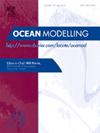Machine learning-based intelligent parameterization of source functions in numerical wave model
IF 2.9
3区 地球科学
Q2 METEOROLOGY & ATMOSPHERIC SCIENCES
引用次数: 0
Abstract
In recent years, although the application of machine learning in parameterizing complex marine physical processes has gradually become widespread, most of the existing studies rely on statistically correlated parameter selection methods for neural network construction and lack physical support. This study proposed a physics-guided neural network parameterization method combining physical feature selection and data-driven modeling. By integrating source function parameterization equations (wind input, wave breaking dissipation, wave-wave nonlinear interactions) from the MASNUM-WAM physical framework into the feature engineering of a backpropagation neural network (BPNN), a physically guided parameterization model was developed. The experiments show that the three major source functions exhibit excellent prediction performance (R²>0.95, RMSE<0.09, BIAS between -0.02 and 0.05), with stable results across multi-test points. Then, a new directional wave spectra prediction model was developed using the prediction results. Directional wave spectra predictions show strong consistency with MASNUM-WAM (COR>0.92, RMSE<0.09 m²s, |BIAS|≤0.03 m²s). Spectral integration parameters achieve high accuracy: significant wave height (RMSE≤0.477 m), mean wave direction (RMSE≤1.010°), and mean wave period (0.203 s≤RMSE≤0.247 s). Feature importance analysis reveals that wave breaking dissipation contributes most substantially to directional wave spectra prediction accuracy, while initial conditions, wave-wave nonlinear interaction, wind field components exhibit variable influence, and wind input term maintains a minor but consistent role. This physics-guided approach retains data-driven advantages while enhancing model reliability and computational efficiency, offering a new pathway for parametric research in ocean wave simulation.
数值波模型中基于机器学习的源函数智能参数化
近年来,虽然机器学习在参数化复杂海洋物理过程中的应用逐渐广泛,但现有的研究大多依赖于统计相关的参数选择方法来构建神经网络,缺乏物理支持。提出了一种结合物理特征选择和数据驱动建模的物理导向神经网络参数化方法。通过将MASNUM-WAM物理框架中的源函数参数化方程(风输入、破波耗散、波-波非线性相互作用)整合到反向传播神经网络(BPNN)的特征工程中,建立了物理导向的参数化模型。实验表明,三个主要的源函数具有良好的预测性能(R²>0.95, RMSE<0.09, BIAS在-0.02 ~ 0.05之间),并且在多个测试点上结果稳定。然后,利用预测结果建立了一种新的定向波谱预测模型。方向波谱预测结果与masnu - wam具有较强的一致性(COR>0.92, RMSE<0.09 m²s, |BIAS|≤0.03 m²s)。光谱积分参数精度较高:有效波高(RMSE≤0.477 m)、平均波向(RMSE≤1.010°)、平均波周期(0.203 s≤RMSE≤0.247 s)。特征重要性分析表明,破波耗散对定向波谱预测精度的影响最大,初始条件、波波非线性相互作用、风场分量的影响是变化的,风输入项的影响较小,但作用一致。该方法在保持数据驱动优势的同时,提高了模型可靠性和计算效率,为海浪模拟参数化研究提供了新的途径。
本文章由计算机程序翻译,如有差异,请以英文原文为准。
求助全文
约1分钟内获得全文
求助全文
来源期刊

Ocean Modelling
地学-海洋学
CiteScore
5.50
自引率
9.40%
发文量
86
审稿时长
19.6 weeks
期刊介绍:
The main objective of Ocean Modelling is to provide rapid communication between those interested in ocean modelling, whether through direct observation, or through analytical, numerical or laboratory models, and including interactions between physical and biogeochemical or biological phenomena. Because of the intimate links between ocean and atmosphere, involvement of scientists interested in influences of either medium on the other is welcome. The journal has a wide scope and includes ocean-atmosphere interaction in various forms as well as pure ocean results. In addition to primary peer-reviewed papers, the journal provides review papers, preliminary communications, and discussions.
 求助内容:
求助内容: 应助结果提醒方式:
应助结果提醒方式:


